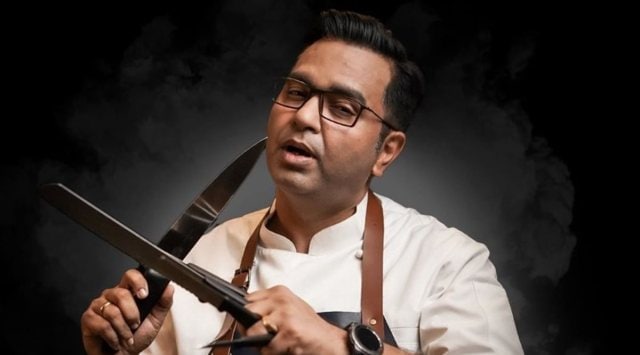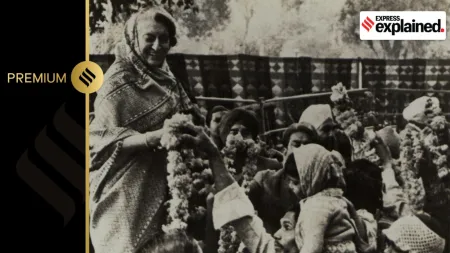- India
- International
‘The most complex thing about Indian food is its flavours’: Chef Ajay Chopra
"Indian food, generally, derives its flavours from not more than 15-20 ingredients, but each dish changes its flavour because of the way the spices have been used, the way the meat has been treated -- which, I think, is the most complicated part to achieve," he said
 One cooking tip that I always swear by, is to cook with patience, says the chef. (Photo: Chef Ajay Chopra/Instagram)
One cooking tip that I always swear by, is to cook with patience, says the chef. (Photo: Chef Ajay Chopra/Instagram)‘Global chef with a desi heart’, that’s how chef Ajay Chopra likes to introduce himself — at least on Instagram. But the culinary wizard wears more than just one hat as he is also a restaurant consultant, the host of MasterChef India, a judge on Zee Cafe’s Chef Vs Fridge Season 2, and the European Union’s Ambassador for the ‘More Than Food’ campaign in India, that aims to create awareness about the diverse and rich nature of ingredients and agricultural products from the EU.
In an exclusive interaction with indianexpress.com, the chef talks about sustainable food practices in India, the changing food habits, Indian food on the global map, and also shares his favourite condiments along with a few cooking tips and tricks! Read on:
In the last few years, sustainability has become a buzzword in the hospitality industry. What exactly does the term mean to you?
Sustainability in the hospitality industry has come a long way from just reusing towels and saving water. The hotel industry is now taking a wider approach and incorporating sustainable practices in their food to limit their negative impact on the environment and the communities that produce them. I believe that sustainability is not just an added feature anymore, it has become a way of life — right from specific ingredients that go into the preparation of meals to the final plate that guests taste. Everyone should be and is increasingly becoming responsible for a sustainable, and eco-friendly way of eating. It is important to source food products that are farmed or produced sustainably.
Sustainability also means a whole lot of things, a whole lot of parameters. To give you a quick example, we use onions but we throw away the onion peel. However, the peel is an excellent colouring agent for soups. So, if you want to give a nice golden brown colour to your soup, you can use onion peel. In many international restaurants, there are no dustbins available because they use every single part of the ingredients.

According to you, what is the best approach when it comes to sustainable consumption of food, and how popular is the ‘Farm to Fork’ strategy in India?
The availability of a varied and versatile range of food products, while still bringing authenticity and quality to the table to create a transformational eating experience. The ‘Farm to table’ strategy has become increasingly popular in India in the past few years. This concept not only has nutritional benefits but is also environmentally friendly and is in sync with the healthy food revolution globally.
View this post on Instagram
Tell us about the European Union’s agri-food products and their USPs?
The agricultural products from the European Union are a lot more than just food and drinks. They are a collection of flavours that are bursting with characters, tracing back to their origin. Each ingredient has a unique story to tell, which is a heritage that has been passed down through generations. The products are built around quality and tradition, with an emphasis on genuine and unique ingredients that are subject to rigorous regulations at every stage of their production, processing and packaging. The food and farming standards of the food from the EU are of high quality, authentic, sustainable and safe products resulting in huge demand all over the world. Their ingredients are a clear example of authenticity, safety, sustainability, and quality.
Do you think that food habits have changed in the last two years? If yes, how and in what ways?
The pandemic has resulted in people becoming more health conscious, hence over the last couple of years, their food consumption habits have changed to a large extent. Staying indoors has pushed people to experiment with their cooking as well. For the past two years, this has become a lifestyle for most people, hence if you ask me, this is a good change and seems like it is here to stay.
What would you say is the most complex thing about Indian food?
The most complex thing about Indian food is its flavors. Indian food, generally, derives its flavours from not more than 15-20 ingredients, but each dish changes its flavour because of the way the spices have been used, the way the meat has been treated — which, I think, is the most complicated part to achieve. Apart from that, to maintain the sense of balance of spices and cooking right so that you change the texture and flavour completely can also get a little complicated.
View this post on Instagram
Which Indian herb/seasoning/condiment/spice would you call the most versatile, and why?
One herbs that complements every dish is coriander. I think one of the reasons we can’t do without it is because it’s great for garnishing. It also adds great flavour to the dish when it is cooked a little, either in the beginning of the process or at the end. There are various recipes that call out different steps in different ways in which coriander can be used and for me, I think that is quite versatile. The most versatile spice, for me, is cinnamon. The world uses it in several ways. Our curries are bland without it, and it can even be used for desserts and soups. It has good health benefits and is useful in reducing cholesterol. At the same time, it completely transforms the dish that it is added into.
One cooking tip you swear by…
That would be to cook with patience. I am a firm believer of the teachings of the Bible, and it says ‘Love is Patient, Love is Kind’, and I take that sentiment to my kitchen. When you cook for your loved ones, you want to do it patiently and reflects in the final dish. The older generation, like our mothers and grandmothers, showcased immense patience while cooking. A simple process of sauteing onions would take 20 minutes, but would bring out the flavour of any dish or cuisine. To sum it up, yes cooking equals passion, but it also equals patience.
View this post on Instagram
How do you plan to approach the show and experiment with the mystery ingredients that you will have to work with?
Chef Vs Fridge is all about bringing the best out of chefs. The show is built to showcase the excellent chefs from some of the top restaurants in India. In the show, the audience can witness India’s very good chefs competing against each other for the title of ‘Culinary Champion of the Week’ and unless we throw great challenges at them, great dishes won’t come out. Mystery ingredients will force them to think out of the box and will prompt them to showcase their inbuilt creativity. But the boss chiller, the refrigerator, has been very unkind to me (laughs), always throws up a challenge that I want to run away from, but all challenges must be accepted. And cooking becomes exciting when it has ample challenges.
Do you think Indian cuisine has earned its due credit on the global culinary map?
It is now the beginning for India. Indian cuisine has finally started to get credit on the world map. You know, in the latest books that rate restaurants in the world have started to understand that India has some great restaurants chefs. Previously, we were confined to the same dishes, the same menu but now things have changed. We are not just butter chicken or biryani but much more than that. So, chefs are coming up with more regional delicacies with their twists which are recreating magic on international plates.
View this post on Instagram
How often do you use leftovers to create magic in the kitchen? Which leftover dish do you think is the easiest to work with?
I think each home in India uses leftover food to recreate new dishes, every single day. Right from my childhood, I have been seeing my mom using leftover dal to create parathas or puris or leftover saag to do some kind of a wrap. For me, leftover food is not just something that you have to finish off, but I think is something that allows you to think creatively. I love taking leftover food and giving it a new tadka, thinking completely fresh about it. I could possibly do an aloo gobi salad from a leftover aloo gobi adding some fresh and cooked elements into it, creating a crunch and a soft feel. So, I think very differently when it comes to food and believe in giving it a new twist altogether.
📣 For more lifestyle news, follow us on Instagram | Twitter | Facebook and don’t miss out on the latest updates!
More Lifestyle
May 09: Latest News
- 01
- 02
- 03
- 04
- 05


































